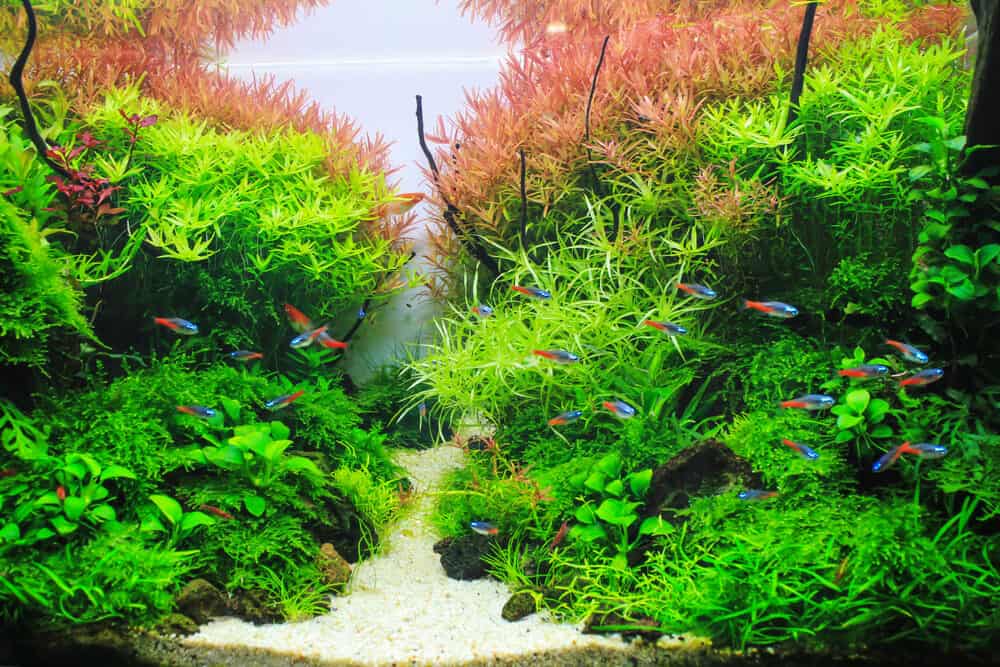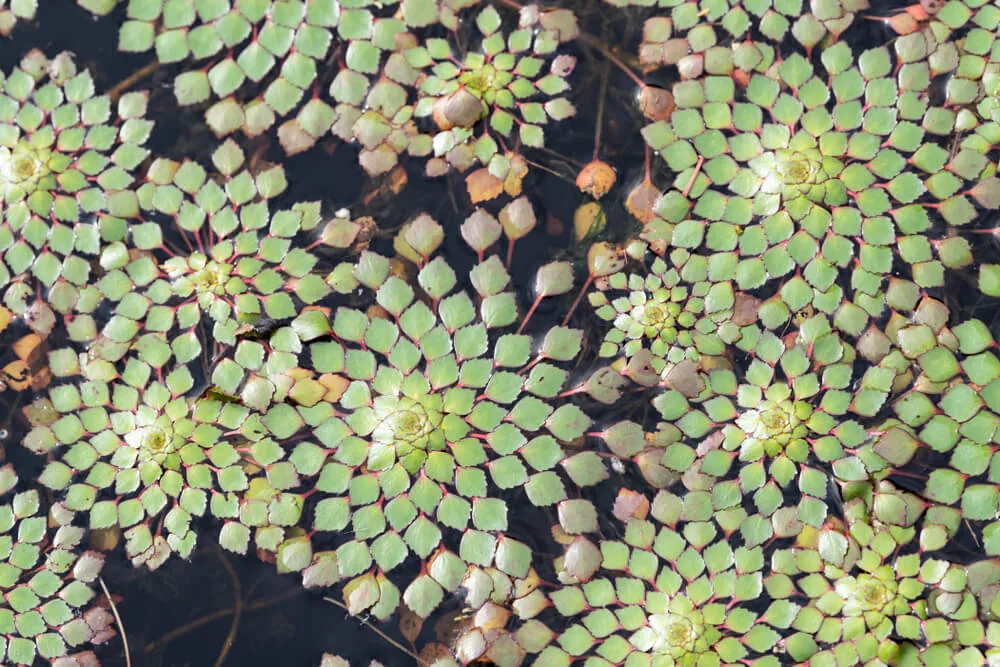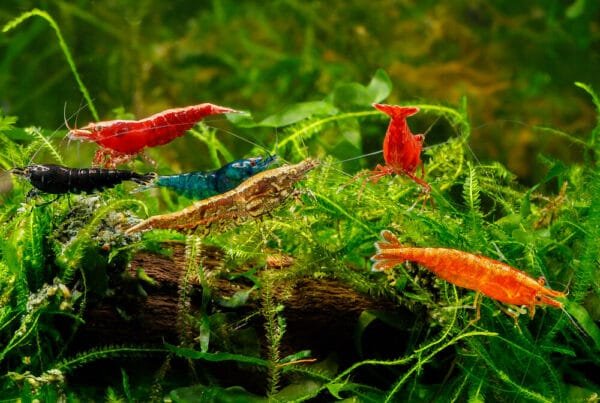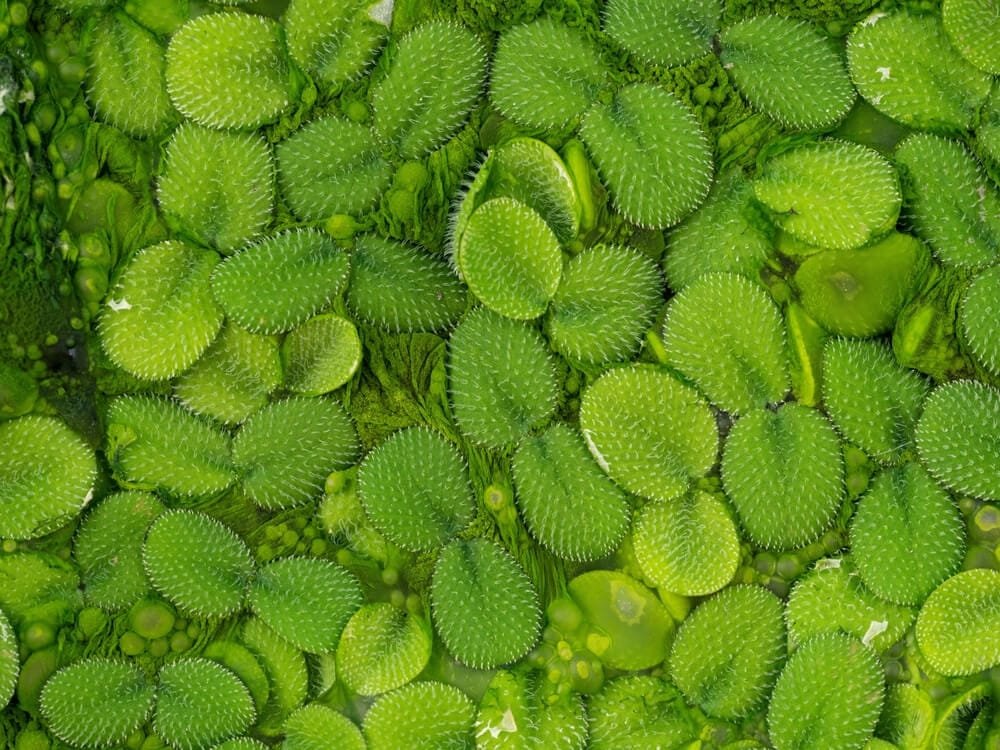Low tech aquarium plants not only make a fish tank look more vibrant and maintain the water parameters more effortlessly. These plants are also a cinch to grow and care for, making them the best aquarium plants for novice aquarists.
Although low-tech aquatic plants are suitable for beginners, they still demand a few requirements worth considering.
These aquarium plants need the correct lighting, nutrition, and water flow to survive and thrive in an aquarium without injecting carbon dioxide or using intense lighting in the fish tank.
So, how do you care for low-tech aquatic plants, and what plants are perfect for beginner aquarists? Let’s find out.
Understanding Low-Tech Aquarium Plants
Your quest for the best low-tech aquatic plants starts with an understanding and appreciation of what they are.
Low tech aquarium plants do not require fancy technologies to survive, especially a carbon dioxide injector mechanism. They also do not need intense lighting to photosynthesize and perform other life functions.
Beginner aquarists must understand that plants need water, nutrients, light, and carbon dioxide to grow and thrive. Unfortunately, living under the water can present many challenges without the correct technologies.
For instance, there’s less dissolved carbon dioxide in the water than in the air, requiring the introduction of the gas through a device.
Light cannot penetrate deeper waters, while most aquarium substrates don’t have the necessary nutrients to support plant life. Technologies answer many of these obstacles to successfully growing aquarium plants.
However, some plant species can survive and thrive in low carbon dioxide and low light environments.
These life forms take their nutrients from organic matter from a few fish in the tank or from commercially available, high-quality liquid fertilizers. They also grow best in low o moderate-intensity lighting, requiring no fancy setups.
Low-tech aquatic plants are slow-growing and with lower energy requirements than so-called ‘high-tech’ plants. This distinction separates them from other aquarium plants, and it would be great not to forget.
The Ten Best Low-Tech Aquarium Plants For Beginners
You’ve many aquatic plant choices to add to your low-tech aquarium. If you’re curious and prefer to have a shorter list to work with, you can start with the following ten recommendations for the best low-tech aquatic plants for beginners.
1. Marimo Moss Ball

You’ll love these green orbs dotting the foreground of your aquarium. Although they’re neither plants nor moss but Cladophora algae, Marimo mosses make excellent low-tech aquatic plants.
They are perfect for goldfish and Betta aquariums, providing fuzzy play balls for your fish.
Invertebrates love to nest on these orbs, while algae grazers can nip at the balls now and then.
The best part is that Marimo mosses do not demand meticulous care except for maintaining their round shape during weekly water changes.
2. Cryptocoryne Wendtii

Crypts are a favorite of aquarium hobbyists because they’re easy to grow and demand little to no attention.
Cryptocoryne wendtii is perfect for beginners because it does not require carbon dioxide injection and liquid fertilizers. It can thrive in any substrate, including inert substances, as long as you provide root tabs every three to four months.
They’re available in green, red, tropica, and brown, giving you the chance to add color to your fish tank.
If you want the red C. wendtii’s color to pop out, you can add iron supplements to the water.
3. Vallisneria

This grass-like aquatic plant is perfect for hobbyists who want a jungle-like vibe in their aquariums.
Vallisneria is one of the most straightforward plant species to grow, requiring a single plant to create an aquatic forest.
Although it grows best in a CO2-rich environment, Vals can thrive in non-CO2 ecosystems with adequate liquid fertilizers and root tabs.
A haven for African cichlids and goldfish, Vallisneria produces side shoots that root in the substrate. They can extend their foliage out of the water, adding a different scenery to the fish tank.
4. Aponogeton Crispus

The smooth-flowing, wavy-edged leaves of Aponogeton crispus are like a ballerina dancing in the aquarium. It’s a betta bulb you can place on top of your fish tank substrate, leave it there, and watch it sprout roots and leaves.
These low-tech aquatic plants are inexpensive yet grow pretty fast.
The Aponogeton crispus might even reward you with flowers if you take care of it. It should make your fish tank more appealing.
5. Java Fern

This low-tech aquatic plant has different looks, such as a lace pattern, a trident form, and the more common narrow leaf. However, the most popular Java fern has deeply ridged veins in its long, pointed leaves.
Planting the Java fern in your aquarium requires wedging the rhizome into wood or rock crevices and securing it with a thread.
Easy to care for, Java ferns make excellent plants for aquariums that don’t require adequate lighting and carbon dioxide.
6. Bacopa Caroliniana

Here’s a stem plant that doesn’t demand too much attention, lighting, and carbon dioxide. However, the Bacopa caroliniana thrives best when it receives a healthy dose of weekly liquid fertilizers.
Intensifying the aquarium lighting can turn the tips of the Bacopa’s leaves into coppery red.
You can also achieve this effect in low light conditions by adding a few drops of iron supplements every week.
7. Anubias Barteri

A staple in low-tech aquariums, the Anubias barteri is a hardy aquatic plant that doesn’t need to grow in soil.
It can propagate in driftwood and allows for effortless movement around the aquarium. It’s the perfect low-tech plant for those who want varied aquascapes now and then.
Being one of the most flexible aquatic plants, hobbyists use it to hide unsightly aquarium elements.
You can plant this underneath floating aquatic plants without worrying about its photosynthetic capabilities.
8. Ceratopteris Thalictroides

Hobbyists call this aquatic plant ‘water sprite,’ a hardy amphibious fern that can populate your fish tank within several weeks. Ceratopteris thalictroides can be a floater or a planter, giving you versatility in planting decisions.
The water sprite is an excellent mid-ground plant, bridging the gap between a mossy foreground and tall grassy background.
You can prune the leaves if they grow larger than usual or start shading neighboring plants.
9. Potted Tall Hairgrass

Growing up to 20 inches, the Potted Tall Hairgrass makes an excellent choice for large fish tanks. They have a moderate growth rate and zero maintenance and carbon dioxide requirements.
These thin grasses move with the water flow, producing an effect similar to hair swimming in the water.
The only attention this aquatic plant demands is periodic trimming, lest it grows out of the aquarium. The Potted Tall Hairgrass is perfect as a background plant in aquariums.
10. Dwarf Hairgrass

If you like the Potted Tall Hairgrass except for its height, you’ll love the Dwarf Hairgrass.
This aquatic plant grows to four inches, making it an excellent foreground element. Besides its short stature, propagating the Dwarf Hairgrass is also easier because it spreads horizontally.
The Dwarf Hairgrass is perfect for community fish tanks, giving tiny fishes plenty of blades to hide.
It is also suitable for spawning fish, timid species, fish fry, and juveniles.
Picking The Best Low-Tech Aquarium Plants For Your Fish Tank
We presented the easiest aquarium plants to care for without requiring state-of-the-art carbon dioxide injectors or fancy lighting setups. However, we also recognize you might want to look for your preferred low tech aquarium plants. Here are a few pointers to help you decide.
Decide Whether To Get A Planter Or A Floater
Aquatic plants come in two varieties: floaters and planters.
Floating aquarium plants have their roots dangling in the water and leaves just below or slightly above the water surface.
These plants make excellent hiding places for skittish fish, breeders, eggs, juveniles, and tiny fish and crustaceans.
Unfortunately, floaters can block the light going to the plants at the aquarium’s bottom, leaving them unable to photosynthesize.
On the other hand, planters have their roots firmly in the aquarium substrate.
Their thick foliage rises the water column, offering a safe refuge for small fish, tiny shrimp, juvenile fish, eggs, fry, and anxious fish species trying to escape predators.
Sadly, these plants are permanent in their places, making pre-planning crucial.
The good news is that many low-tech aquatic plants can be both a planter and a floater, depending on how you want to place them in your tank.
Consider Your Aquarium’s Layout
Your aquarium has three coronal sections – front, middle, and back. Low-tech aquatic plants come in different sizes.
It would be best to place the smaller plant species in the foreground and the taller and larger plants in the background.
For example, you can add Marimo moss balls and Christmas moss in the foreground while putting Java fern, Cryptocoryne lutea, and Bacopa caroliniana in the background.
Forming the mid-ground is Vallisneria or Aponogeton crispus. This setup allows you to retain an excellent view of your fish tank while giving enough hideouts for your fish.
Are Your Aquarium Plants Food For Your Fish?
You don’t need to consider this if you don’t intend to add herbivorous fish to your aquarium.
Otherwise, it would be useless to feature low-tech aquatic plants that would otherwise become food for your fish.
Unless that is your intention, it would be best to consider more suitable tank mates for your plants.
For example, Panaque catfish species, bristle-nosed catfish species, and Plecos are herbivorous aquarium fish that will not think twice about snacking on your low-tech aquatic plants.
Your best bet in this setup is a carnivorous fish, such as Bettas, pufferfish, Tetras, and Oscars.
Think About Adding Color To Your Fish Tank
Most aquatic plants are green. However, you would not want to limit your fish tank colors to an emerald hue. Some low-tech aquatic plants are red or orange, adding vibrancy to your aquarium.
If you must go green, we recommend using different shades for contrast.
You can place a forest green or Sacramento green plant in the background, tropical forest green or olive in the mid-ground, and neon green, lime green, or laurel green in the foreground.
Always Pick Healthy, Algae-free, And Strong Low-tech Aquatic Plants
Always buy your low-tech aquatic plants from reputable sellers. Inspect the plants carefully, noting any diseased parts, discolorations, and other signs of illness or algae growth.
You don’t want to introduce a sickly plant into your aquarium.
Although washing the plants with plain water will do, it is best to immerse your newly bought aquatic plants in a water-hydrogen peroxide solution for three to five minutes to kill bacteria, fungus, and other microorganisms that can contaminate the aquarium.
Be careful not to oversoak the plants in the solution because it can damage the foliage.
Promoting The Growth Of Low-Tech Aquatic Plants
Although low tech aquatic plantsdon’t need carbon dioxide injection, they require a different kind of care.
The good news is you only need to set them up properly and observe regular dosing of liquid fertilizer.
Here’s how to ensure your low tech aquarium plants thrive and contribute to a beautiful fish tank teeming with life.
Use Good-quality, Nutrient-rich Aquarium Soil
High-quality, aquarium soil is better than inert substrates, such as gravel and sand.
This aquarium substrate contains a higher concentration of nutrients for optimum plant growth in the long term, eliminating the need for adding fertilizer to the substrate.
Aquarium soil also has organic matter that slowly decomposes over time, fueling your plant’s sustained growth.
Alternatively, you can layer the aquarium bottom with high-quality fertilizer before topping it off with about 2.5 inches of inert sand or gravel. The plants’ roots should take their nutrients from the lowermost layer.
Unfortunately, this doesn’t work with floating aquatic plants. The remedy is to add daily or weekly liquid fertilizer to the water.
Start Planting On 50% Of The Aquarium
The key to a successful low-tech aquascape is to aim for a heavily planted aquarium.
Plants stabilize the fish tank ecosystem by absorbing ammonia, nitrates, nitrites, heavy metals, and other organic compounds in the water.
Densely planting the aquarium at the very beginning also eliminates algae growth.
Start by covering 50% of the fish tank’s livable area with low-tech plants. This proportion is enough to prevent algae from getting a foothold and spawning uncontrollably.
Ideally, plants should dominate about 70% of your aquarium’s available space to ensure optimum ecosystem stabilization and defense against algae.
Consider Shallow And Wide Fish Tanks
Most aquarists choose a tall rectangular tank for their aquariums.
However, they might not be the best for low-tech plants, especially considering their lighting requirements.
A wide and shallow aquarium is better because aquatic plants have more room to ‘breathe’ in carbon dioxide and more extensive lighting options.
Observe Regular Fertilizer Application
Although using nutrient-rich, high-quality aquarium soil can eliminate the need for fertilizers, it would still be best to add liquid fertilizer to the water at regular intervals.
You must realize that fish waste and uneaten food are insufficient to supply your aquatic plants with the necessary nutrients, especially since you cannot overstock your aquarium.
A weekly dose of liquid fertilizer is necessary to sustain your plants’ steady growth.
Manufacturers have different fertilizer dosing recommendations. It would be best to observe the guidelines to ensure optimum plant development.
Tame Your Aquarium Lighting
Low-tech aquatic plants don’t have stringent lighting requirements. However, you won’t want to promote algae growth by increasing the light intensity and exposure time.
You’ll need to study your aquatic plants’ photo exposure needs.
Most low-tech aquatic plants thrive in low to moderate-intensity lighting between eight to ten hours daily. You’ll also want to ensure all plants in the aquarium receive sufficient light, making shallow fish tanks suitable.
It’s essential to remember that increasing the photo exposure and light intensity also increases the aquatic plants’ need for carbon dioxide and nutrients.
Frequently Asked Questions
What Is The Easiest Aquarium Plant To Keep?
Aquarists consider the Marimo Moss Ball the aquarium world’s easiest aquatic plant to keep.
It’s naturally occurring Cladophora algae that form a dark green orb, requiring only regular maintenance of its round shape.
You can lightly roll the Cladophora orb in your hands during aquarium water changes, ensuring every single alga receives sufficient light.
What Is Low Tech Aquascape?
A low-tech aquascape is a planted aquarium without a machine injecting carbon dioxide.
There was a time when people considered a CO2 injector a high-tech device necessary for ensuring the survival, growth, and development of aquatic plants.
We know plants need at least four things to survive – water, light, nutrients, and carbon dioxide.
Aquarium plants thrive in water with light that diffuses from the top. Unfortunately, the water might not contain sufficient carbon dioxide, requiring its introduction via a device.
However, many aquatic plants survive and thrive in the wild without any gadget injecting carbon dioxide gas into the water.
Hence, people wanting to create a low-tech aquascape must use aquatic plants that don’t require carbon dioxide injection.
Do Planted Tanks Need Filters?
No, planted tanks don’t need filters. However, it’s often advisable to get a mechanical filter to help remove debris and particles the aquatic plants cannot absorb.
Aquarists who want to go filterless in their planted aquariums might also want to consider a few pointers.
It would be best to tip the plant-to-fish ratio in favor of aquatic plants.
Seasoned aquarists with heavily planted fish tanks stock their aquariums with fewer fish than a lightly planted or fish-only tank.
You’ll want your heavily planted aquarium with a very-low bioload from undigested fish food and fish waste. This setup allows the plants to absorb all dissolved carbon dioxide and nitrogenous wastes in the water.
Aquarium lighting is crucial when going filterless. However, you don’t want to stimulate robust plant growth because it will increase carbon dioxide requirements.
Aquarists who decide to go filterless with a heavily planted tank should opt for low to medium-intensity lighting to balance photosynthesis and CO2 need.
Going filterless on a heavily planted tank requires more frequent weekly water changes. It’s also crucial to vacuum the substrate to remove excess fish excreta and uneaten food.
Many seasoned aquarists recommend a 25% water change every week to keep the ecosystem’s integrity.
It would be best to use a sponge filter if you cannot observe these recommendations for a filterless heavily-planted aquarium.
How Many Hours Of Light For Low Tech Planted Tank?
Aquatic plants in low-tech aquariums need eight to ten hours of continuous, medium-intensity lighting to promote optimum photosynthesis and plant growth.
However, some plant species might require a longer or shorter photo exposure.
Whatever the case, it’s essential not to light your low-tech plants for more than twelve hours to prevent algae from overrunning your aquatic ecosystem.
It would also be best to start your new aquatic plants with six hours of daily photo exposure to jump start their growth and facilitate acclimatization.
You can gradually increase the light exposure until you reach the ideal eight to ten hours.
How Can I Grow Aquarium Plants Without CO2?
You can grow aquarium plants without carbon dioxide by understanding a plant’s energy requirements – a combination of light, water, nutrients, and CO2.
High energy aquarium plants need bright light, strong water flow, high CO2 levels, and sufficient daily fertilizer.
Growing aquatic plants without CO2 requires reducing the other elements – lighting, fertilizer, and water flow.
Start with a nutrient-rich substrate, such as aquarium soil. You can also try layering the fish tank with substrate fertilizer before topping it with gravel. Alternatively, you can push fertilizer balls into the substrate.
You can also promote steady plant growth by adding a high-quality liquid fertilizer weekly during the weekly water change.
An alternative is to calculate the daily fertilizer dose from the weekly average and add the amount to the water every day.
Lastly, opt for slow-growing, low-energy aquarium plants. These species must be healthy, strong, and algae-free before planting.
Conclusion
Low tech aquarium plants can add color and life to a thriving fish tank ecosystem without requiring complicated setups or costly technologies.
Not only do you beautify your aquarium, but you also replicate your fish and plants’ natural environment right in your room.
You don’t need every single low-tech aquatic plants we’ve shared here in your aquarium.
Start with one or two plant species and take care of them. You can always add more as you grow more proficient in your aquarium-keeping adventures, ensuring the best-looking and thriving aquatic ecosystem you can take great pride in.







